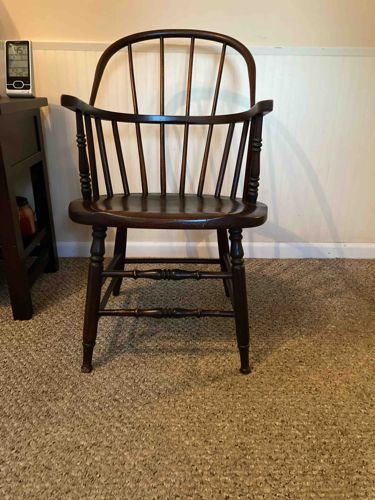
Dark Stained Windsor Armchair
This is a classic Windsor-style armchair, likely constructed from a hardwood such as oak, maple, or a similar indigenous timber, finished with a dark, possibly walnut or mahogany-toned, stain. The chair features a bowed back rail supported by seven turned spindles that connect to the seat. The armrests are gracefully curved and terminate in turned supports at the front, which join the legs. The legs themselves are turned, showcasing a spool or ring turning pattern, and are connected by H-stretchers that also exhibit turning details, adding to the chair's overall decorative appeal and structural integrity. The seat is a solid, saddle-shaped piece, providing ergonomic comfort, with a slightly darker and more uniform finish than the turned elements, suggesting potential saddle wear or a slightly different wood grain. The condition appears to be good for its age, showing a rich patina consistent with use, minor scuffs, and surface wear might be present on the legs and armrests, which is typical for a piece of this style and age. There are no immediately visible signs of major damage, repairs, or structural instability. The craftsmanship is indicative of traditional woodworking techniques, with clearly defined turnings and sturdy joinery. This style of chair was popular from the late 18th century through the 19th and early 20th centuries, suggesting an estimated age range from late Victorian to early 20th century. The robust construction and timeless design contribute to its enduring appeal.
AI-Generated Appraisal Disclaimer
Estimated Value
$400-700
Basic Information
Category
Furniture
Appraised On
December 7, 2025
Estimated Value
$400-700
Item Description
This is a classic Windsor-style armchair, likely constructed from a hardwood such as oak, maple, or a similar indigenous timber, finished with a dark, possibly walnut or mahogany-toned, stain. The chair features a bowed back rail supported by seven turned spindles that connect to the seat. The armrests are gracefully curved and terminate in turned supports at the front, which join the legs. The legs themselves are turned, showcasing a spool or ring turning pattern, and are connected by H-stretchers that also exhibit turning details, adding to the chair's overall decorative appeal and structural integrity. The seat is a solid, saddle-shaped piece, providing ergonomic comfort, with a slightly darker and more uniform finish than the turned elements, suggesting potential saddle wear or a slightly different wood grain. The condition appears to be good for its age, showing a rich patina consistent with use, minor scuffs, and surface wear might be present on the legs and armrests, which is typical for a piece of this style and age. There are no immediately visible signs of major damage, repairs, or structural instability. The craftsmanship is indicative of traditional woodworking techniques, with clearly defined turnings and sturdy joinery. This style of chair was popular from the late 18th century through the 19th and early 20th centuries, suggesting an estimated age range from late Victorian to early 20th century. The robust construction and timeless design contribute to its enduring appeal.
Related Tags
Get Your Items Appraised
Instant estimates of your treasures with AI-powered instant appraisals